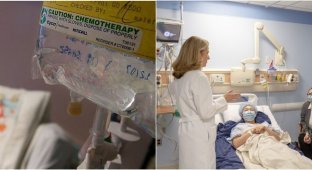Childbirth without pain? Is it possible? (5 photos)
Back in the early 19th century there was such a thing as “twilight sleep.” The newspapers were full of headlines that the suffering of women in childbirth had stopped, thanks to doctors. But what was the matter? 
It all started in Germany back in 1906: Karl Gauss and Bernhard Kroning (two obstetricians) mixed an amazing anesthetic cocktail consisting of a mixture of scopolamine and morphine. Morphine relieved pain, and scopolamine caused patients a slight euphoria, drowsiness, and then amnesia. This combination, however, did not turn the woman into a vegetable - she perfectly understood what the doctors were telling her and followed their instructions. 
The experiments carried out, according to Gauss and Kroning, showed that the technique leads to a reduction in complications of labor and began to popularize “twilight sleep” at the Baden State University.
Of course, rumors that it was possible to give birth without hours of agony and complications first spread throughout Germany and then around the world. Women from Africa and the USA began to come to Baden - everyone wanted to be relieved of their burden as comfortably as possible.
Thousands of happy mothers have told how magical it is to be in “twilight sleep” and some have even resorted to it more than once. Newspapers interviewed girls, who all said that they refused to give birth without a wonderful “cocktail.” The new method had every chance of spreading throughout all maternity hospitals in the world. 
But on the other side of the enthusiasm for the “twilight sleep” stood the doctors. They rang the bells, trying to prove that newspaper articles should not and do not have the right to guide medical practices. All attempts to adopt the German experience: the nurses were inexperienced, measured out the wrong dose of scopolamine, which caused breathing problems for newborns.
The elite service could not become a kind of “for everyone”. In Baden, the patients were kept in a bed that looked more like a cradle, where the women wore eye masks, had cotton plugs inserted into their ears, and wore shirts similar to straitjackets, only not as harsh. And, of course, a doctor was assigned to every woman in labor. In an ordinary hospital, at the beginning of the 20th century, it was almost impossible to recreate such luxurious conditions. 
Time has shown that the problem is not only in organizing such painless childbirth. It turned out that, in fact, the innovative method is essentially no different from the most ordinary childbirth. Yes, women in labor experience the same pain - this was proven by the screams during childbirth and the burns from the fabric strips that were used to tie women to their beds.
The whole point was in the final effect of “twilight sleep” - amnesia. The new mother simply did not remember what she had experienced, and there were even cases when girls did not believe that they had already gone through childbirth and were holding their own child in their arms. 
In 1915, the final verdict on the “twilight sleep” was signed when one of its ardent supporters, Charlotte Carmody, died. During childbirth, she began bleeding, due to which the woman died. Scopolamine had absolutely nothing to do with it, but the popularization of “twilight sleep” abruptly stopped.
But at the same time, scopolamine was used by obstetricians for a long time and only in 1960 it was completely abandoned.


























